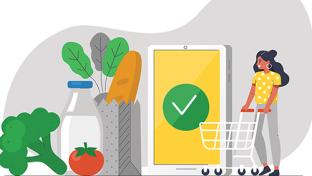How to Use the FDA's Latest Label Changes to Your Advantage
Jan. 1, 2020 , marked the FDA’s deadline for many suppliers to introduce an updated food and beverage label. The new label reflects new perspectives in nutrition science, shifting consumer diet preferences and an increased desire for transparency in consumer packaged goods.
Another shift in consumer preferences that’s happening right now: the rise of online grocery shopping. Together, these two changes present an opportunity for grocers to differentiate themselves. By making new, more informative product label information accessible online, grocers can win over more customers, including those with allergies and special diets.
The secret ingredient is product photography, which can help grocers use newly available label information to attract and convert more customers.
What’s changing: added sugars, different vitamins, new design
Aside from the addition of trans fat to Nutrition Facts in 2006, the FDA food and beverage label has stayed roughly the same for the past 20 years.
But in 2016, the FDA announced that all food and beverage items from manufacturers with $10 million or more in annual sales must get an updated nutrition information label by Jan. 1, 2020.
Many items with the new label are already on shelves. But for grocers rolling out the new label by the new year (note: manufacturers with less than $10 million in annual sales have until 2021), be on the lookout for:
- An added sugar value and % DV (percent of daily value) below the usual sugar information
- The amount of vitamin D, potassium, calcium, and iron replacing vitamins A and C
- Larger fonts for serving size, servings per container and calories
- Larger serving sizes to reflect what people actually eat
For people with allergies, special diets and particular preferences, labels will now be much more helpful in making purchase decisions.
Further, as they get accustomed to the new label format, these consumers might be hesitant to buy online when those labels aren’t visible. That’s why grocers can capitalize on these regulations to drive more conversions from the growing population of online grocery shoppers.
High-quality online product photos will reach more consumers
The number of online grocery shoppers grew rapidly this past year, from 23.1% of all shoppers in 2018 to 36.8% in 2019 — that’s 35 million more online grocery shoppers this year.
But there’s a caveat: 48% of customers want access to detailed product information on websites. If they can’t inspect the Nutrition Facts as they can in-store, they won’t make a purchase.
The solution? Top-quality product visuals.
Shoppers want to see packaging up close, as they would in stores, including the label. High-quality product imagery and 360-degree photography let them do that.
Crucially, by photographing all of their products, grocers can worry less about getting product nutrition information from suppliers to list on their websites. Shoppers with specific needs can just check the label in a product photo.
Pair these images with the right software, and grocers can even extract the data so it’s available for other uses, like creating accessible ingredient lists for shoppers viewing a site with a screen reader.
Another application: making merchandise searchable so shoppers can easily find the products they want.
For instance, say a customer is looking for snacks with minimal added sugars. A database of product label information would let that customer filter for products that have a low count of added sugars on the product label.
When a user knows that they can find all of the items that suit their needs on a specific grocer’s website, they’ll head there first — not to other websites, and perhaps not even to their local store.
Product photos will help boost ecommerce sales for both grocers and suppliers
Getting product information from suppliers is challenging. This is where the new labels and product images can actually strengthen the grocer-supplier relationship: Consumer demand for the new labels gives grocers more bargaining power with product suppliers.
Plus shelf placement in a grocery store is everything: “eye level is buy level,” after all. It’s also very expensive. The pay-to-display model, or paying fees for premium shelf placement, advantages large food suppliers — but it’s often inaccessible for smaller ones.
Smaller brands, then, may be happier forgoing a pricey in-store placement if they can get excellent images for a grocer’s website and that online visibility promotes more sales. It’s a win-win for grocers and suppliers.
Prioritize your digital marketing strategy in 2020
Grocery shoppers who want online options for convenience and ease of navigation will prioritize finding the product information they need.
To drive sales in a space that has nothing but room for innovations in customer experience, grocers should make the most of these new labels and make product visuals a cornerstone of online shopping, just as they already are in-store.








